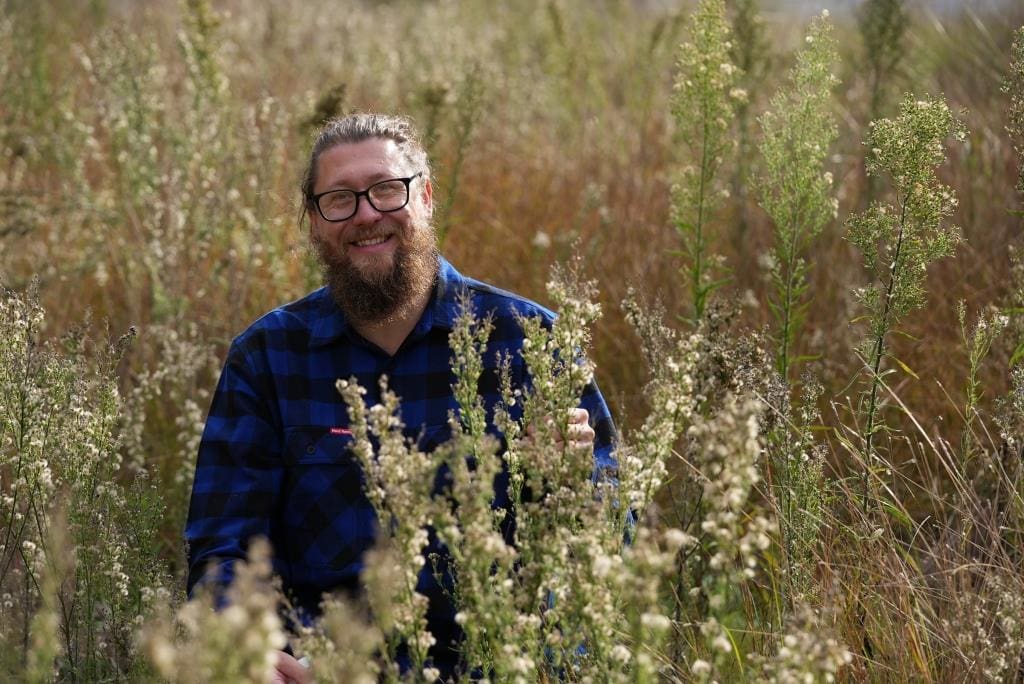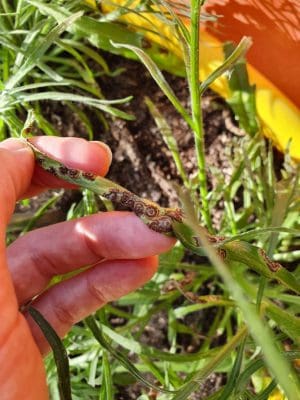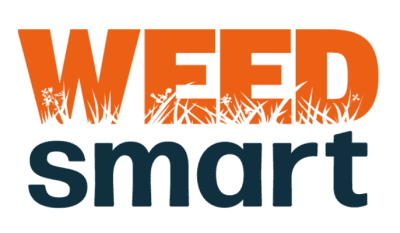
Dr Ben Gooden with a stand of flaxleaf fleabane. Source: CSIRO
AUSTRALIA has an impressive track record with biological control of environmental and pasture weeds.
In recent years, there has been a new focus on difficult-to-control weeds, such as flaxleaf fleabane, in grain production systems.
CSIRO weed ecologist Ben Gooden said flaxleaf fleabane was selected as a target for biological control due to its tolerance of and resistance to herbicide controls, and its spread through the grain-growing regions in response to minimum-tillage farming practices.
“Introducing a biological control agent into Australia involves a rigorous process and a long lead time to ensure that the introduced agent is effective on the target and does not threaten other plant species in the Australian environment,” Dr Gooden said.
“The CSIRO started work on identifying potential agents against fleabane in 2017 and soon identified a rust fungus, Puccinia cnici-oleracei (ex. Conyza), native to Colombia, South America as a strong candidate for controlling flaxleaf fleabane in Australia.”
In 2021, the fungus was approved for release from quarantine and a pilot field-release trial was conducted in 2022 and 2023.
“When flaxleaf fleabane plants are infected with this rust pathogen, the plants produce 50 to 60 percent fewer flower heads and, therefore, less seed than healthy plants.”
“If the pathogen can be established under field conditions in Australia, it will take several years before there is a significant impact on flaxleaf fleabane populations.
“Other examples of successful biological control have typically involved multiple agents, so we are pursuing insects with biocontrol potential to help control fleabane in addition to the fungus.”
Areas beside crops in sights
Controlling flaxleaf fleabane populations in marginal areas adjacent to cropping paddocks with a non-herbicide tactic like biocontrol will potentially reduce the amount of seed produced and available to infest adjacent cropping areas.

Flaxleaf fleabane infected with the biocontrol rust fungus. Photo: CSIRO
The pilot release program in 2022-23 highlighted some practical issues that need to be overcome to ensure a successful establishment and succession of Puccinia cnici-oleracei in various seasonal and environmental contexts in Australia.
Like other rust pathogens, P. cnici-oleracei infects host plants readily under humid conditions during sporulation.
Research has also shown that young seedlings are more susceptible to infection than mature plants.
When monitoring infection levels, it is necessary to observe plants in the release area within the first two to four weeks, before the host leaves die off and are shed from the plant.
P. cnici-oleracei is very specific to flaxleaf fleabane (Conyza bonariensis).
It does not infect tall fleabane (Conyza sumatrensis) or Canadian fleabane (Conyza canadensis).
Insect candidates identified
Experience suggests biocontrol is most effective when multiple agents impact the target weed species.
Native range surveys have been conducted in Colombia and Brazil to identify potential insects that attack flaxleaf and tall fleabane.
To date, researchers have identified three insect candidates: a stem-boring weevil (Lixus caudiger); a leaf-galling midge (Asteromyia modesta), and a stem-gall-forming tephritid fly (Trupanea bonariensis).
Colonies of these insects have been established, and biology studies and preliminary host specificity testing have been undertaken.
These insect colonies are ready for quarantine host testing in Australia if resources become available for ongoing research.
Other weeds under scrutiny
Sowthistle was also identified as a target weed for the grains industry.
However, early research indicated that biocontrol was not feasible, and the resources were redirected to saffron thistle, a grain contaminant, that can reduce grain yields by 10pc or more.
 Native range surveys in France identified a rosette crown feeding fly (Botanophila turcica) as a potential biocontrol agent.
Native range surveys in France identified a rosette crown feeding fly (Botanophila turcica) as a potential biocontrol agent.
The grain industry continues to benefit from the successful biocontrol of parthenium through insects and two rust pathogens, and skeleton weed through a rust pathogen and two insects.
The cost-benefit analysis of the skeleton weed biocontrol program estimated a $112 return for every $1 spent on research.
Both of these biocontrol programs have been sustained since the 1970s and clearly demonstrate the long-term nature of biocontrol, along with the impact of long periods of drought on insect populations and pathogen inoculum in the environment.
This research is part of the Underpinning agricultural productivity and biosecurity by weed biological control project, led by AgriFutures Australia and funded by the Australian Government Department of Agriculture, Fisheries and Forestry as part of its Rural R&D for Profit program, with co-investment from CSIRO, GRDC and NSW Biocontrol Taskforce.
The WeedSmart Big 6 strategy embraces non-herbicide weed control tactics and diverse cropping systems to keep weed numbers low in cropping systems. Learn more about reducing herbicide resistance risk at WeedSmart Week in Port Lincoln on July 29-30.
Source: Cindy Benjamin, WeedSmart



HAVE YOUR SAY